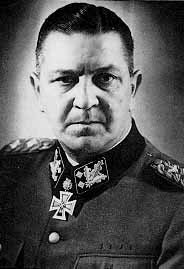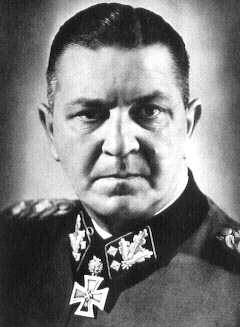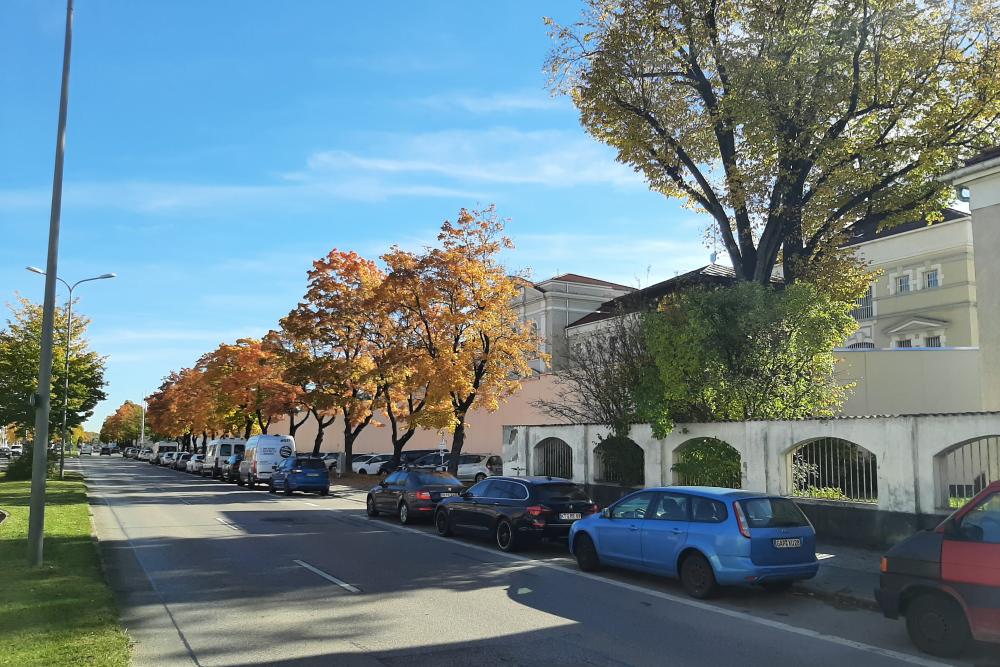Eicke, Theodor 'Papa' (Waffen SS)
- Date of birth:
- October 17th, 1892 (Hampont, Moselle, Alsace-Lothringen, German Empire)
- Date of death:
- February 26th, 1943 (Mikhailovka/Oryol Oblast, Soviet Union)
- Buried on:
- German War Cemetery Zhytomyr
Grave: UNK. - Service number:
- SS-Nr.: 2.921 // NSDAP-Nr.: 114.901
- Nationality:
- German
Biography
Theodor Eicke participated in World War I as a paymaster. He later joined the "Zollgrenzschutz":, which were engaged in the defense of Germany’s eastern borders against Polish attacks following the Great War. Subsequent to this service with the latter formations, Eicke joined the "Schützpolizei" and later a "Detective Bureau".
Eicke had joined the "Polizei" in 1927 and soon thereafter came into contact with the Allgemeine-SS. He became a member and, compared to his fellow officers, was promoted quickly. Together with his comrades in the Allgemeine-SS, as well as with the police, NCOs and enlisted men discharged from the Reichswehr, he set up "Hilfspolizei" squads (auxiliary police units formed in early 1933). These were organized to combat Hitler’s opponents and also to guard them after they had been arrested. Once the new government had obtained power, Eicke formed so-called "SS-Hundertschaften", from which the later "Totenkopfverbände" ("T.-Sturmbanne" and "T.-Standarten") evolved. These men guarded the Oranienburg Concentration Camp near Berlin, as well as the camp at Dachau, north of München. The prisoners in these camps … communists, social-democrats, members of the "Reichsbanner", as well as other opponents of Hitler … were often subjected to brutal treatment.
It should be noted that when Eicke took over the command of all concentration camp personnel, as well as all SS-Totenkopfverbände, he attempted to train these men along army lines, or at least in a manner similar to the training received by the SS-Verfügungstruppe units. When the Reichswehr refused to issue Eicke’s men with light infantry weapons, in contrast to the SS-Verfügungstruppe, Eicke procured such weapons on his own, drawing upon the caches of arms hidden by SA-troopers. Eicke also played a role in the crushing of the "Röhm Putsch", and, as a result of laws passed after 30 June 1934, his units officially became part of the SS under the supreme command of Himmler. Up until that time, they had been directly subordinated to the supreme command of the SA.
At any rate, by 1938/39, Eicke’s troops had all received some basic military training and had been issued with light infantry weapons such as rifles, carbines, pistols, WWI machine-guns, and some mortars. When the Second World War broke out, Eicke formed a division from the Totenkopf units, reinforced by reserves from the Allgemeine-SS, Army reservists and the police. The Division was partially motorized, had been constituted at Dachau (the Waffen-SS training base), and had undergone full military training at Obermünsingen, Württemberg, during the winter of 1939/40.
On 6th February 1943, Eicke was on an inspection flight in a Fiessler-Storch when his plane was shot down by the Soviets and crashed behind their lines. Several attempts were made by reinforced assault squads to recover the remains of their commander. They finally succeeded, after losing several men. Eicke was given an elaborate funeral at one of the cemeteries of the Division near Orelka, Russia. In a manner reminiscent of the funeral rites performed by the ancient Germans upon the death of their tribesmen or kings, Theodor Eicke, or "Papa Eicke", as his troops called him, was laid to rest.
Later, when German forces had withdraw, officers from the divisional staff, together with a few selected men, exhumed Eicke’s corpse and brought it back by truck to Kiev. His remains were not to fall into enemy hands! Officials from the legal section of the military authorities investigated this incident and the officers responsible are said to have been reprimanded.
Promotions:
23.10.1909: Zweijährig-Freiwilliger
01.10.1913: Zahlmeisteraspirant
01.03.1919: Unterzahlmeister
01.03.1919: Zahlmeister
00.12.1919: Polizeipratikant
00.06.1920: Offiziersanwärter
00.00.1921: Polizeihilfsmeister
28.08.1928: SA-Truppführer
29.07.1930: SS-Mann
20.08.1930: SS-Truppführer
27.11.1930: SS-Sturmführer
15.02.1931: SS-Sturmbannführer RDA 30.01.1931
15.11.1931: SS-Standartenführer
21.10.1932: SS-Oberführer
30.01.1934: SS-Brigadeführer
11.07.1934: SS-Gruppenführer
14.11.1939: SS-Gruppenführer und Generalleutnant der Waffen SS
20.04.1942: SS-Obergruppenführer und General der Waffen SS
Do you have more information about this person? Inform us!
- Period:
- First World War (1914-1918)
- Period:
- First World War (1914-1918)
- Period:
- First World War (1914-1918)
- Period:
- First World War (1914-1918)
- Period:
- First World War (1914-1918)
- Awarded on:
- 1934
- Period:
- Second World War (1939-1945)
- Rank:
- SS-Gruppenführer / Generalleutnant der Waffen-SS (Lieutenant General)
- Unit:
- Kommandeur, SS-Totenkopf-Division
- Awarded on:
- January 30th, 1940
- Period:
- Second World War (1939-1945)
- Rank:
- SS-Gruppenführer / Generalleutnant der Waffen-SS (Lieutenant General)
- Unit:
- Kommandeur, SS-Totenkopf-Division
- Awarded on:
- May 26th, 1940
- Period:
- Second World War (1939-1945)
- Rank:
- SS-Gruppenführer / Generalleutnant der Waffen-SS (Lieutenant General)
- Unit:
- Kommandeur, SS-Totenkopf-Division
- Awarded on:
- May 31st, 1940
- Period:
- Second World War (1939-1945)
- Rank:
- SS-Gruppenführer / Generalleutnant der Waffen-SS (Lieutenant General)
- Unit:
- Kommandeur, SS-Division “Totenkopf”, X. Armeekorps, 16. Armee, Heeresgruppe Nord
- Awarded on:
- December 26th, 1941
“On the 28.06.1941 a reinforced Bataillon of the SS-Totenkopf-Division was sent to guard the exposed east flank of the Dünaburg bridgehead, and was subordinated to the 3. (mot) Infanterie-Division upon arrival there. From the frontlines of this Bataillon SS-Gruppenführer Eicke personally gained insight into the situation and initiated the expansion of this bridgehead towards the east. After the SS-Infanterie-Regiment 1 was brought up, this action created the appropriate conditions for the Division’s successful attack towards Kraslau.”
757th Award.
- Period:
- Second World War (1939-1945)
- Rank:
- SS-Gruppenführer / Generalleutnant der Waffen-SS (Lieutenant General)
- Unit:
- Kommandeur, SS-Division “Totenkopf”, X. Armeekorps, 16. Armee, Heeresgruppe Nord
- Awarded on:
- 1941
- Period:
- Second World War (1939-1945)
- Rank:
- SS-Obergruppenführer / General der Waffen-SS (General)
- Unit:
- Kommandeur, SS-Division “Totenkopf”, X. Armeekorps, 16. Armee, Heeresgruppe Nord
- Awarded on:
- April 20th, 1942
88th Award.
- Period:
- Second World War (1939-1945)
- Awarded on:
- 1942
- Period:
- Second World War (1939-1945)
- Awarded on:
- 1942
- Period:
- Second World War (1939-1945)
- Awarded on:
- 1942
- Period:
- Second World War (1939-1945)
- Rank:
- SS-Obergruppenführer / General der Waffen-SS (General)
- Awarded on:
- October 21st, 1942
Sources
- Photo 1: Wilco Vermeer
- - FELLGIEBEL, W.P., Elite of theThird Reich, Helion & Company Limited, Solihull, 2003.
- MOONEY, PETER, Waffen-SS Knights and their Battles, Schiffer Pub Ltd, 2008.
- SCHNEIDER, J.W., Their Honor Was Loyalty!, Bender (R.James) Publishing, 1993.
- THOMAS, FRANZ & WEGMANN, GüNTER, Die Ritterkreuzträger der Deutschen Wehrmacht 1939-1945, Biblio Verlag, Osnabrück, 2000.
- YERGER, M.C., Waffen-SS Commanders, Schiffer Publishing, Ltd., 1999.
- Die Ordensträger der Deutschen Wehrmacht (CD), VMD-Verlag GmbH, Osnabrück, 2002
- Kwasny A., Kwasny G., Die Eichenlaubträger 1940-1945 (CD), Deutsches Wehrkundearchiv, Lage-Waddenhausen, 2001
- Axis Biographical Research































